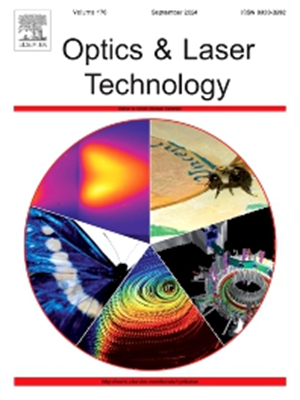Laser-arc hybrid welding of 25 mm high strength steel sections
IF 5
2区 物理与天体物理
Q1 OPTICS
引用次数: 0
Abstract
This research delves into the underlying mechanisms of laser-arc hybrid welding (LAHW) for 25 mm-thick EH36 high-strength steel, examining the impact of varying groove widths on the welding process. Experimental results show that the groove width substantially influences weld formation, arc characteristics, and droplet transitions. Narrower grooves are prone to sidewall arc attraction, which increases the likelihood of arc interruptions and the deflection angles of droplets. A wider groove width promotes a more stable arc, more consistent droplet transitions, and enhanced weld formation. Microstructural analysis reveals that narrower grooves correlate with rapid cooling rates in the lower regions of the weld, resulting in a higher martensite content and increased hardness. Wider grooves are associated with slower cooling rates, a higher formation of bainite, and a less pronounced trend of hardness increase.
With a 4 mm groove width, the LAHW process, consisting of a double-layer and two passes, was successfully applied to achieve single-sided welding that resulted in a double-sided formation in the 25 mm-thick EH36 high-strength steel. The resulting weld is defect-free and predominantly composed of columnar crystals. Hardness testing shows a general increase in hardness values within the weld zone, with variations observed in the remelting zone of the two weld layers. Tensile tests show that the weld achieves a maximum tensile strength of 553 MPa, with all samples fracturing in the base metal and exhibiting ductile fracture characteristics. The tensile strength of the weld meets the requirements of the base metal, indicating good ductility and toughness. The average impact energy of the base material is 138.9 J, the average impact energy of the heat-affected zone is 97.6 J, and the average impact energy of the weld is 109.0 J.
25mm高强度型钢的激光-电弧复合焊接
本研究深入研究了25 mm厚EH36高强度钢激光电弧复合焊接(LAHW)的潜在机制,研究了不同坡口宽度对焊接过程的影响。实验结果表明,坡口宽度对焊缝成形、电弧特性和熔滴过渡有很大影响。较窄的凹槽容易受到侧壁电弧的吸引,这增加了电弧中断的可能性和液滴的偏转角度。更宽的坡口宽度促进更稳定的电弧,更一致的液滴过渡,并加强焊缝形成。显微组织分析表明,较窄的凹槽与焊缝较低区域的快速冷却速率有关,从而导致较高的马氏体含量和硬度增加。较宽的凹槽与较慢的冷却速率、较高的贝氏体形成和较不明显的硬度增加趋势有关。采用4毫米坡口宽度的LAHW工艺,包括双层和两道,成功地实现了单面焊接,从而在25毫米厚的EH36高强度钢中形成了双面结构。由此产生的焊缝是无缺陷的,主要由柱状晶体组成。硬度测试显示焊接区内的硬度值普遍增加,在两个焊接层的重熔区观察到变化。拉伸试验表明,焊缝最大抗拉强度为553 MPa,所有试样均在母材中断裂,呈现韧性断裂特征。焊缝的抗拉强度满足母材的要求,具有良好的延展性和韧性。母材的平均冲击能为138.9 J,热影响区的平均冲击能为97.6 J,焊缝的平均冲击能为109.0 J。
本文章由计算机程序翻译,如有差异,请以英文原文为准。
求助全文
约1分钟内获得全文
求助全文
来源期刊
CiteScore
8.50
自引率
10.00%
发文量
1060
审稿时长
3.4 months
期刊介绍:
Optics & Laser Technology aims to provide a vehicle for the publication of a broad range of high quality research and review papers in those fields of scientific and engineering research appertaining to the development and application of the technology of optics and lasers. Papers describing original work in these areas are submitted to rigorous refereeing prior to acceptance for publication.
The scope of Optics & Laser Technology encompasses, but is not restricted to, the following areas:
•development in all types of lasers
•developments in optoelectronic devices and photonics
•developments in new photonics and optical concepts
•developments in conventional optics, optical instruments and components
•techniques of optical metrology, including interferometry and optical fibre sensors
•LIDAR and other non-contact optical measurement techniques, including optical methods in heat and fluid flow
•applications of lasers to materials processing, optical NDT display (including holography) and optical communication
•research and development in the field of laser safety including studies of hazards resulting from the applications of lasers (laser safety, hazards of laser fume)
•developments in optical computing and optical information processing
•developments in new optical materials
•developments in new optical characterization methods and techniques
•developments in quantum optics
•developments in light assisted micro and nanofabrication methods and techniques
•developments in nanophotonics and biophotonics
•developments in imaging processing and systems

 求助内容:
求助内容: 应助结果提醒方式:
应助结果提醒方式:


